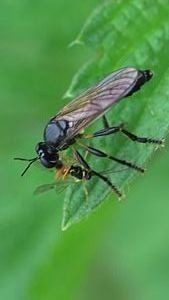Acerocnema macrocera
(Acerocnema macrocera)

Description
Acerocnema macrocera is ainthe dung fly family (Scathophagidae). With a body length of about 3 mm, Acerocnema macrocera is an unusually small species of the dung fly family. The thorax is colored gray with two darker lines visible. The abdomen is black, the legs yellowish-red, with a conspicuous thorns of the front legs (such as occurs in the genus Norelisoma) missing. The large tentacles are black, slightly yellowish at the base. In contrast to many other representatives of the dung flies, the wings do not have any conspicuous markings, but are colored yellowish at the base. The scutellum has two pairs of bristles, orbital bristles and ocellar bristles are present and the palpi are greatly expanded. The species has so far been recorded from Italy, Austria, the Czech Republic, Slovakia, Hungary, Germany, Belgium, the Netherlands, Denmark, Finland, Sweden and Poland. In Germany, sites from Bavaria, Lower Saxony and Thuringia are known. Acerocnema macrocera is an early spring species whose activity period begins in the first third of March and ends in early May. Adult flies are found in populations of the fingered corydalis (Corydalis solida), where mate search and mating also takes place. The females lay their eggs on the developing pods of the corydalis. The species was described by Meigen in 1826 as Cordylura macrocera and incorporated by Becker in 1896 into the genus Acerocnema, which he had newly set up. This genus now includes five species, of which only A. macrocera is native to Central Europe.
Taxonomic tree:







